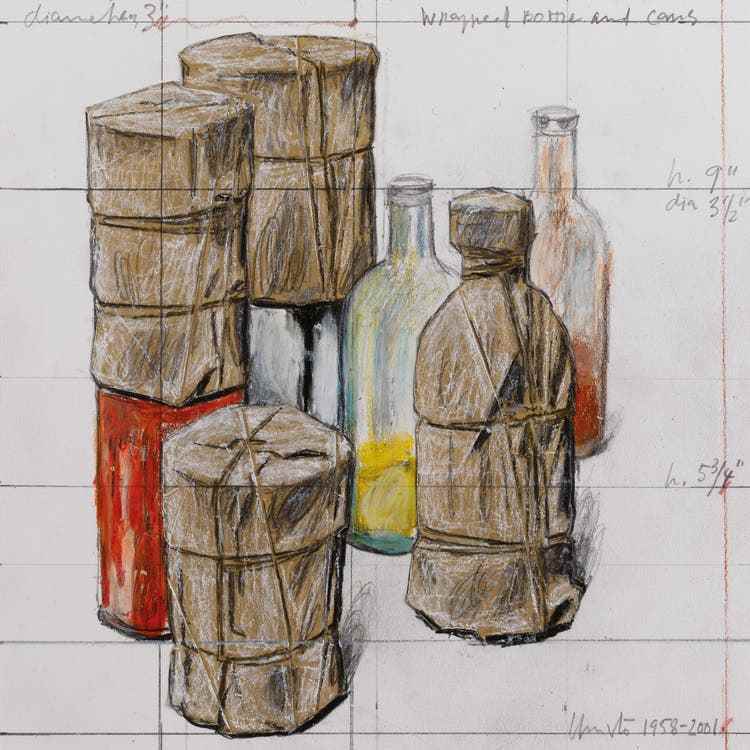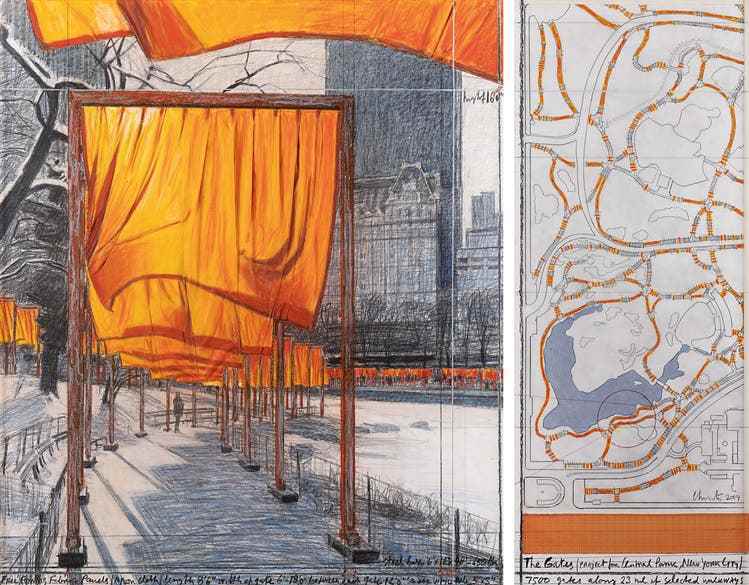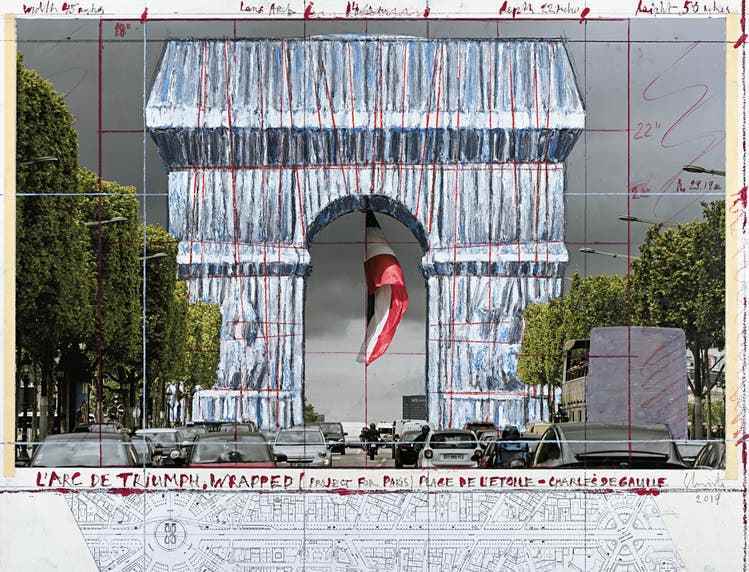Almost two and a half years after Christo’s death, the Düsseldorf Kunstpalast rolled out the red carpet for the virtuoso and his congenial partner Jeanne-Claude. The opulent exhibition leaves nothing to be desired – and yet raises questions.
Christo and Jeanne-Claude in front of the wrapped Reichstag in Berlin, which attracted more than five million people in 1995.
As an art student in Sofia, Christo had a strange weekend job. The budding artist, who began his studies at the Academy of Fine Arts in the spring of 1953, was regularly sent by the Bulgarian Communist Party to the Orient Express route. His job there: he was to help the farmers to present their agricultural equipment in a favorable light for train passengers bound for Paris or Istanbul. The party wanted to give the appearance of a thriving agrarian society. Christo created a temporary illusion.
This planted the seed for his later cover-up actions. They are not about political propaganda, but about an inner-artistic mission. The buildings, monuments, bridges, islands, lakes and rivers that Christo Vladimirov Yavashev and his wife Jeanne-Claude Denat de Guillebon used on a grand scale from the 1960s are not intended to demonstrate anything, they only celebrate art. And indirectly the duo themselves, who pushed through their mostly controversial projects in public space with ingenuity, tactical skill, infinite patience and iron will. Making the impossible possible was the favorite pastime of the marathon couple, who only proclaimed their joint authorship in 1994.
Oil Barrel Sculptures
In the Düsseldorf Kunstpalast, there is now an opportunity to review the tour de force again – almost two and a half years after the death of Christo (1935-2020), who outlived his congenial partner (1935-2009) by more than a decade. Mainly thanks to the loans from the German collector couple Ingrid and Thomas Jochheim, the exhibition “Christo and Jeanne-Claude. Paris. New York. Boundless» draw from the full. Christo had a good connection to Düsseldorf early on. Although he chose Paris as his new home after fleeing Bulgaria, he and Jeanne-Claude came regularly to the Rhineland at the beginning of the 1960s and were represented there with exhibitions.

Christo: « Wrapped bottle and cans », 1958–2001, graphite, chalk and oil pastel on cardboard.
So there is a lot to be said for the Kunstpalast as a place of presentation. Although the overview, which contains around 70 works, opens up the entire spectrum of his work, it also focuses on the early phase: Christo turned his back on Bulgaria in 1957, kept his head above water with commissioned portraits and moved to Paris in 1958, where he met Jeanne-Claude . He quickly came into contact with the artist group Les Nouveaux Réalistes, founded by the critic Pierre Restany. Although he sympathized with their focus on everyday objects, he remained an outsider. Christo’s “Cratères” high reliefs from this phase appear in the Kunstpalast alongside works by Arman, Niki de Saint Phalle, Jean Dubuffet, Lucio Fontana and Yves Klein.
However, Christo’s actual awakening experience during this period did not take place in the circle of the Nouveaux Réalistes, but in a warehouse for old oil drums. He discovered it near his studio in Gentilly, south of Paris. The oil barrel became the preferred object of his first wrappings and overpaintings. What’s more, the artist lined up one barrel after another, piled them up on top of each other and erected barricades, some in galleries, some in public spaces. Oil barrels as building blocks of sculptures run through the entire work. The culmination of this was Christo’s last work, the “Mastaba” project for Abu Dhabi, which would require 410,000 oil drums. If this legacy ever comes to fruition, it would be taller than the Pyramid of Cheops in Egypt.
impermanence and memory
The fact that the veil was almost an all-purpose weapon for Christo can be seen from a number of objects in the exhibition in the Kunstpalast. Magazines, telephones, luggage, cars, bicycles, shop windows, trees, statues – basically everything was a good object to try out the method. “The medium is the message” – Marshall McLuhan’s formulation also applies to Christo’s art. But what is this message? Whoever covers something usually has the intention of hiding it from view. At the same time, the packaging can fuel curiosity and arouse the desire to reveal what lies beneath. One can learn from fashion that the textile cover clearly surpasses the aesthetic appeal of the naked truth. Camouflage and mummification also play a role in this complex psychological process. One thing is for sure: nobody played the keyboard of the wrapping with such virtuosity as Christo and Jeanne-Claude.

Christo: «The gates. Project for Central Park, New York City», 2004, pencil, fabric, crayon, charcoal, enamel paint, hand-drawn map.
From chamber play to symphony concert, their work expanded through the land art and urban art that the couple tirelessly promoted after moving to New York in 1964. In 1968, the Kunsthalle Bern was the first museum that Christo and Jeanne-Claude covered with a polyethylene cover tied with cords, which was removed after a week and disposed of without leaving any residue. The artists not only accepted the transience of this feat of strength – it formed the core of the concept, as did self-financing (through the sale of editions) and the military preparations, which sometimes stretched over decades. What remained at the end were photos, Christo’s pictorially executed, almost photo-realistic project studies and memories.
A map of the world in the Düsseldorf exhibition demonstrates the global claim of the “covering company”. The 24 cover-up coups that were realized are documented there, as are the 46 Sisyphus projects that failed to receive approval from the authorities. The show in the municipal art museum gives a lot of space to the show: First, the wrapped Reichstag in Berlin, which attracted more than five million people in 1995 and became both a symbol of German reunification and the phenomenon of “art spectacle”. Secondly, the Arc de Triomphe in Paris, whose wrapping in autumn 2021 Christo was no longer allowed to witness. Thirdly, the mastaba megalomania that Christo and Jeanne-Claude have been promoting in the United Arab Emirates since 1977. It should be permanently installed.
A model in the exhibition confronts the oil drum gigantomania with a few staffage figures – you almost have to look for them with a magnifying glass. If the “Mastaba” project were to become a reality, it would be a testament to genius and megalomania. One does not know whether one should wish for such a work of art.

Christo: «Veiled Arch of Triumph (project for Paris) – Charles de Gaulle», 2019, pencil, wax crayon, enamel paint.
«Christo and Jeanne-Claude. Paris. New York. Boundless», Kunstpalast Düsseldorf, until January 22, 2023. From March 16 to October 8, 2023 in a different form in the Museum for Art and Cultural History Schloss Gottorf, Schleswig.
